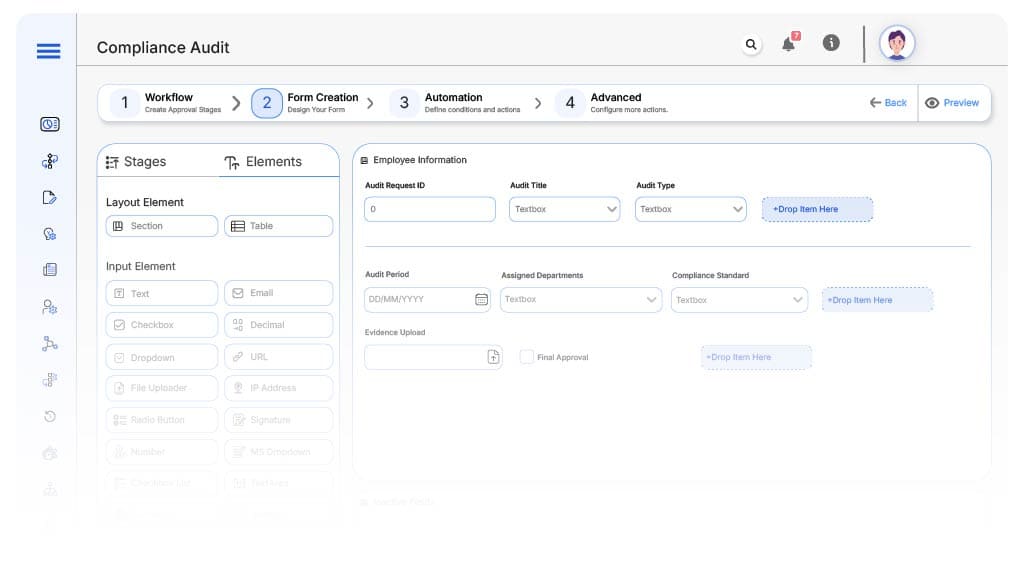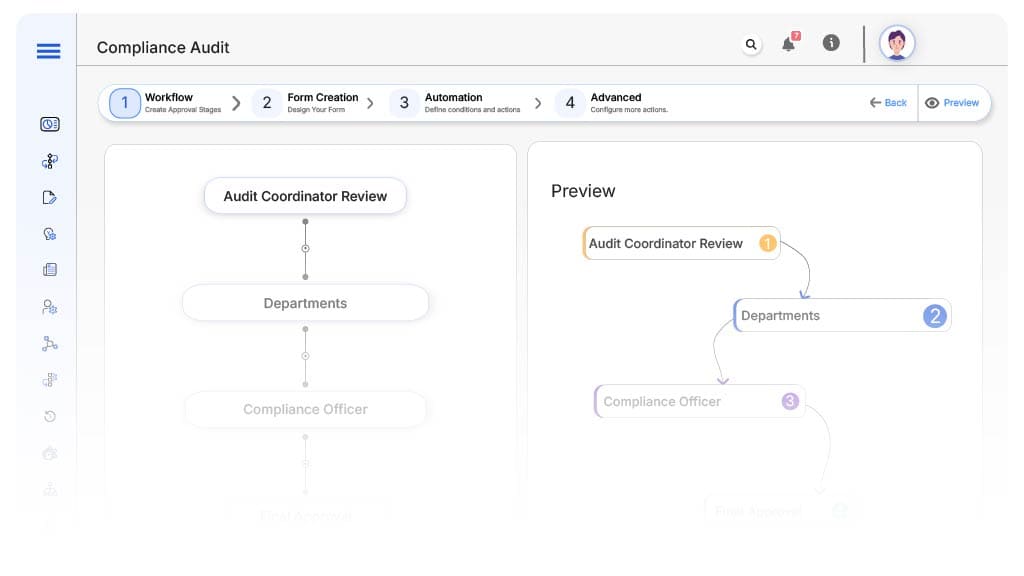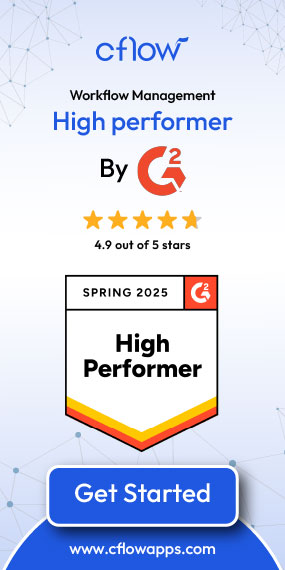- Cflow
- Compliance Audit Automation
Compliance Audit Automation

Clow Team

Compliance audits are essential for verifying whether business operations adhere to internal policies, legal requirements, and industry standards. However, manual audits are plagued with scattered data, missed deadlines, inconsistent formats, and lack of visibility. According to recent audit studies, over 60% of companies face audit failures due to poor documentation and lack of centralized control.
Without automation, audit teams chase down data, send reminders manually, and struggle with fragmented reports across departments. This guide walks you through how Cflow automates Compliance Audit Processes – from audit scheduling and evidence collection to approvals and archiving.
What Is Compliance Audit Automation?
Compliance Audit Automation is the digital transformation of the audit lifecycle—automating the scheduling, data collection, task tracking, reviewer sign-offs, and audit report generation. It ensures all audit activities are traceable, deadline-driven, and policy-aligned.
For example, when a quarterly finance audit is due, Cflow automatically notifies departments, assigns document upload tasks, routes findings for review, and compiles the final audit pack. Audit trails, approvals, and non-compliance actions are captured in real time.
According to compliance benchmarks, automated audits reduce reporting errors by 70% and cut prep time by 50%.
Why Compliance Audit Automation Is Critical
Regulatory Compliance
Risk Mitigation
Operational Accountability
Audit Trail Generation
Key Benefits of Automating Compliance Audits with Cflow
- Centralized Audit Dashboard: Cflow offers a live dashboard where audit coordinators track the status of all ongoing audits. You can filter by department, compliance area, audit type, and status, ensuring no audit step is overlooked or delayed. It gives real-time visibility into overdue audits, team performance, and escalation patterns.
- Automated Audit Schedules & Checklists: Cflow lets you configure recurring audit cycles (quarterly, monthly, annual) with customizable checklists. Teams are automatically notified of their responsibilities, and tasks are tracked until submission or escalation. Checklist templates can be cloned, edited, and version-controlled for future audits.
- Multi-Department Collaboration: Audit workflows span multiple functions—Finance, HR, Legal, IT, Procurement. Cflow routes the right checklist items to the right owners, captures evidence uploads, and enforces deadlines across silos. Inter-departmental visibility helps eliminate bottlenecks and improves turnaround.
- Evidence Collection & Review: Each audit item can require a document upload, signature, comment, or system log. Cflow ensures these are completed before moving forward and enables multi-level reviews by Compliance and Audit Heads. Stakeholders can annotate attachments or flag incomplete submissions for revision.
- Real-Time Notifications & Escalations: Automated alerts remind stakeholders of upcoming due dates and escalate pending tasks. Escalations can be configured to notify Audit Heads or Compliance Officers if timelines slip. All reminders are tracked, ensuring accountability and eliminating the need for manual follow-ups.
- Audit Trail & Archival:
Every submission, approval, comment, and document is timestamped and archived. Reports can be filtered and downloaded for board reviews, inspections, or compliance certifications. The audit log is tamper-proof and meets data retention requirements for up to 7 years. - Policy & Standard Reference Integration: Each audit step can include reference links to applicable regulations or policies (e.g., ISO 27001, GDPR, SOX), making it easier for teams to comply without confusion. Built-in references improve training, reduce errors, and support first-time audit readiness.
Get the best value for money with Cflow
User Roles & Permissions
Department Owner
- Responsibilities: Complete checklist tasks, upload evidence, respond to queries.
- Cflow Permission Level: Task Owner.
- Mapping: “Functional Teams” group.
Audit Coordinator
- Responsibilities: Launch audits, assign tasks, monitor progress, finalize reports.
- Cflow Permission Level: Admin.
- Mapping: “Audit Team” group.
Compliance Officer
- Responsibilities: Review submissions, validate compliance, mark findings.
- Cflow Permission Level: Approve/Reject.
- Mapping: “Compliance Team” group.
Department Head
- Responsibilities: Approve audit findings, assign action plans.
- Cflow Permission Level: Approve/Reject.
- Mapping: “Management” group.
Auditor
- Responsibilities: View audit logs, export reports, verify archived records.
- Cflow Permission Level: View Only.
- Mapping: “Audit Viewer” group.
Discover why teams choose Cflow
Form Design & Field Definitions

Field Label: Audit Request ID
- Type: Autonumber
- Auto-Populate Rules: Generated on submission.
Field Label: Audit Title
- Type: Text
- Auto-Populate: Manually entered by coordinator
Field Label: Audit Type
- Type: Dropdown (Internal, Regulatory, ISO, Finance, Vendor)
- Logic/Rules: Drives checklist template
Field Label: Audit Period
- Type: Date Range
- Logic/Rules: Required
Field Label: Assigned Departments
- Type: Multi-select
- Logic/Rules: Routes checklists
Field Label: Compliance Standard
- Type: Dropdown (SOX, GDPR, ISO 9001, HIPAA, etc.)
- Logic/Rules: Links to relevant checklists
Field Label: Checklist Item
- Type: Repeating Group (Text description, required evidence, due date)
- Logic/Rules: Required per task
Field Label: Evidence Upload
- Type: File Upload
- Logic/Rules: Mandatory for completion
Field Label: Reviewer Comments
- Type: Text Area
- Logic/Rules: Visible only to Compliance
Field Label: Final Approval
- Type: Checkbox
- Logic/Rules: Required to close audit
Transform your Workflow with AI fusion
Approval Flow & Routing Logic

Submission → Audit Coordinator Review
- Status Name: Audit Plan Review
- Notification Template: “New audit created: {Audit Title}. Please assign departments and checklist.”
- On Approve: Routes to Departments
Coordinator → Departments
- Status Name: Checklist Tasks Assigned
- Notification Template: “Hi Team, please complete audit checklist items for {Audit Title} by {Due Date}.”
- Escalation: Reminder after 3 days
Departments → Compliance Officer
- Status Name: Compliance Review
- Notification Template: “All tasks submitted for {Audit Title}. Please review evidence and findings.”
- On Approve: Routes to Department Head
Compliance Officer → Department Head
- Status Name: Department Sign-Off
- Notification Template: “Hi {Head}, review audit findings and approve or assign action plans.”
- On Approve: Moves to Final Audit Sign-Off
Final → Audit Complete
- Status Name: Audit Closed
- Notification Template: “Audit {Audit Title} is now complete and archived for recordkeeping.”
Transform your AI-powered approvals
Implementation Steps in Cflow
Create a new workflow
Design the form
Set up User Roles/Groups
Build the process flow diagram
Configure notifications
Set logic
Save and publish workflow
Test
Go live
Example Journey: Q2 Vendor Audit
FAQ's
Yes. Each audit has a unique ID, separate workflows, and independent tracking dashboards.
Absolutely. You can schedule monthly, quarterly, or annual audits with auto-launch logic.
Yes. Full audit logs and findings can be exported in Excel or PDF formats for board or regulatory reporting.
Unleash the full potential of your AI-powered Workflow

